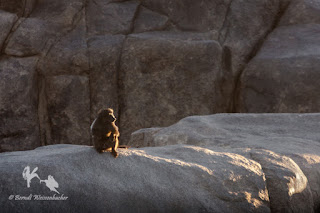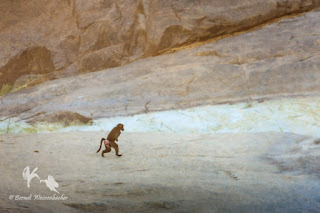In December of 2009, my wife
and I were visiting the Augrabies Falls National Park in the Northern Cape
Province of South Africa. This park is renowned for its waterfall, a place
called Aukoerebis (Place of Great
Noise) by the original Khoi inhabitants of this very arid, semi-desert and very
rocky region of the Nama-Karoo. Here the Gariep
River first plummets approximately 60 metres over a narrow lip into a gorge
scoured out of a basement of granite rock. The gorge is over 18 kilometres long
and averages 240 metres in depth. The sides of the gorge are sheer and polished
smooth.
The surrounding countryside is
equally spectacular. The vegetation is typically dry, low, open woodland and
bushveld. Cutting through this semi-desert environment run ridges of volcanic
rock and breath-taking polished granite domes.
On our last day, we visited
the falls before sunrise. The mist thrown up by the thundering Gariep was backlit by the first rays of
the sun. A half hour later, a small troop of chacma baboons made its way, in
total shadow, along the lip of the gorge directly opposite. I was concentrating
on these clowns of the bushveld, hoping to spot an exciting composition.
I had been looking at the
members of the troop for about 15 minutes when I noticed a straggler at the
rear of the troop moving much more slowly and much more deliberately along the
boulders of the opposite lip of the gorge.
I could see that this was a
female – the engorged behind could not be missed. However, this baboon was
bipedal, walking on her hind legs only. Peering through my telephoto lens, I
could see that this female baboon had lost both of her hands. Her front legs
ended abruptly – they seemed to have been severed in some accident, probably
from a farmer’s gin or spring trap.
She did not seem to be too
encumbered by her disfigurement as she ran at a trot on her two hind legs. My
heart started pounding. What I was witnessing was a primeval scene; I thought
immediately of the evolution of a human-like bipedal primate some 4 – 5 million
years ago as witnessed in the spectacular fossil record of our ancestors in
South and East Africa.
The spray from the waterfall
that morning was heavy, frequently obscuring the opposite wall of the gorge. I
managed to take only three snaps, the last one as the female was starting to
run past a pool of water in a deeper nook of the canyon wall.
When I finally had a chance to
look at these extraordinary images after the long journey home, the classical
music of ‘In the Hall of the Mountain
King’ resounded through my head:
Far
away
In
a land caught between
Time
and space
Where
the books of life lay
We
fear
This
castle of stone
The
mountain king roams
All
alone in here
But
(s)he's
not the only one
Lost
inside
Forever
hidden from the sun…
Edvard
Grieg




No comments:
Post a Comment